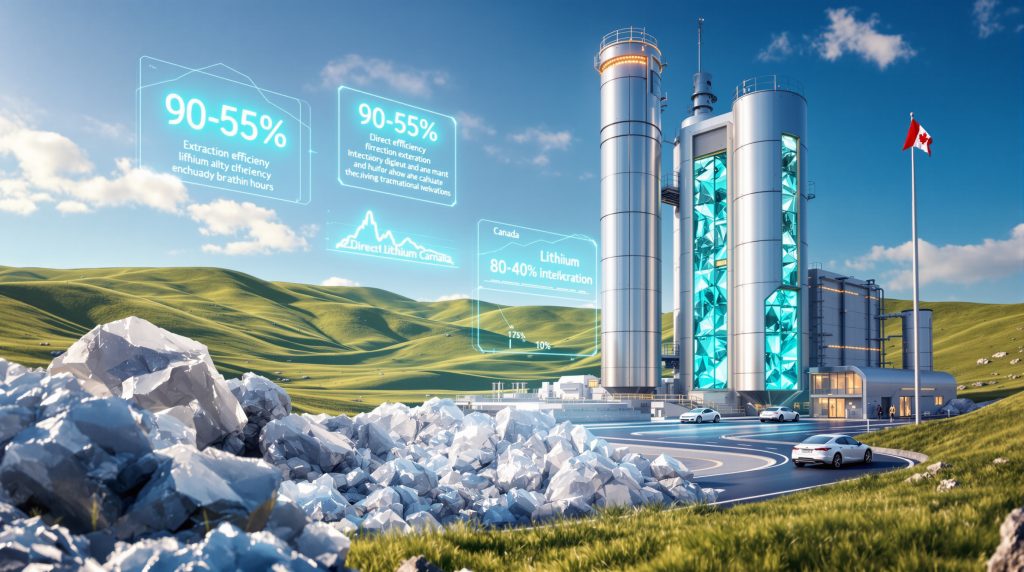What Makes Direct Lithium Extraction Technology a Game-Changer?
Direct lithium extraction represents a fundamental transformation in mineral processing technology, offering dramatically accelerated production timelines compared to conventional evaporation methods. Unlike traditional approaches that can require months of processing time, a direct lithium extraction facility can extract lithium from brine sources using selective separation techniques that operate continuously.
The technology's commercial viability has been proven through real-world implementations across North America. Standard Lithium's Arkansas facility, which became operational in 2024, demonstrates the scalability potential of commercial-scale DLE units. This operational success has provided confidence for larger developments, including Prairie Lithium's Saskatchewan project, which aims to establish North America's largest known DLE facility.
Key technological advantages driving adoption include:
• Enhanced processing efficiency through selective separation methods
• Reduced dependency on weather conditions affecting evaporation
• Modular design capabilities allowing phased development
• Integration potential with existing infrastructure
The selective nature of DLE technology allows operators to target specific lithium concentrations while minimising processing of unwanted materials. This precision approach reduces waste generation and optimises resource utilisation, making previously marginal brine resources economically viable for development.
Why Are Major Mining Companies Racing to Build DLE Facilities?
The global lithium market outlook faces unprecedented pressure from accelerating battery demand across multiple industries. Electric vehicle manufacturing, energy storage systems, and consumer electronics require secure, consistent lithium supply chains that traditional extraction methods struggle to provide at the necessary scale and speed.
Market dynamics have shifted decisively toward supply chain diversification, particularly in North America and Europe, where manufacturers seek to reduce dependency on single-source suppliers. Furthermore, Prairie Lithium's engagement in multiple offtake discussions with partners across North America and Asia reflects this strategic demand for geographically distributed lithium production.
Critical market drivers accelerating investment:
• Battery manufacturing capacity expansion across Western markets
• Government incentives supporting domestic critical mineral production
• Supply chain resilience requirements from automotive manufacturers
• Technology maturation reducing operational risk
The rapid development timeline demonstrated by projects like Prairie Lithium's Saskatchewan facility underscores industry maturity. Paul Lloyd, the company's managing director, noted that rapid project advancement reflects both technological readiness and growing global significance of secure lithium supply chains.
Industry participants recognise that early deployment of commercial-scale DLE facilities provides competitive positioning in an increasingly supply-constrained market. Companies establishing operational DLE capabilities now position themselves advantageously for long-term supply contracts with battery manufacturers and automotive companies requiring predictable lithium access.
Where Are the World's Largest DLE Facilities Currently Operating?
North America's Emerging DLE Infrastructure
Prairie Lithium's Saskatchewan Project
The Williston basin in Saskatchewan hosts what promises to become North America's largest known direct lithium extraction facility. Prairie Lithium's project represents a significant milestone in commercial-scale DLE deployment, with four commercial-scale columns currently under fabrication.
Project Development Timeline:
• Foundation completion: January 2026
• Four DLE columns arrival: April 2026
• Grid connection application submitted to SaskPower
• Commercial operations targeting mid-2026
The project's design emphasises sustainability principles, targeting reduced freshwater consumption, minimal land disturbance, and lower waste generation. This environmental focus aligns with regulatory expectations and corporate sustainability requirements across North American supply chains.
Arkansas Commercial Operations
Standard Lithium established operational precedent in 2024 with its Arkansas commercial-scale DLE unit, providing technological validation for subsequent projects. The Arkansas operation has demonstrated DLE scalability and operational reliability, building industry confidence in the technology's commercial viability.
This operational success has created a technological foundation that Prairie Lithium acknowledges as crucial for its Saskatchewan development. The Arkansas facility's performance data and operational learnings directly inform larger-scale deployments across North America.
International DLE Development
While North America leads in large-scale DLE facility development, international projects are advancing across multiple jurisdictions. However, direct lithium extraction technology transfer and operational expertise from early deployments are accelerating global DLE adoption, with particular focus on regions with established brine resources and supportive regulatory frameworks.
The geographic distribution of DLE facilities reflects strategic positioning near battery manufacturing centres and automotive production hubs, minimising transportation costs and supply chain complexity. In addition, the US lithium production trends demonstrate how North American facilities are establishing the foundation for broader international expansion.
How Do DLE Facilities Compare to Traditional Lithium Extraction Methods?
Direct lithium extraction offers distinct operational advantages over conventional evaporation pond methods, particularly in processing speed and environmental impact. Traditional evaporation requires extensive surface areas and favourable climate conditions, while DLE facilities operate in compact, controlled environments.
Operational Comparison Framework:
| Factor | Evaporation Ponds | Direct Lithium Extraction |
|---|---|---|
| Processing Control | Weather-dependent | Climate-independent |
| Surface Requirements | Extensive pond systems | Compact industrial facilities |
| Processing Timeline | Seasonal variations | Continuous operation |
| Water Management | High evaporation losses | Closed-loop systems |
The sustainability advantages of DLE become particularly relevant in regions with water scarcity or environmental protection requirements. Prairie Lithium's Saskatchewan project specifically targets reduced freshwater use and minimal land disturbance, addressing key environmental concerns associated with traditional extraction methods.
DLE technology also enables development of brine resources in locations unsuitable for evaporation ponds, such as regions with high precipitation, limited surface area availability, or strict environmental regulations. This geographic flexibility expands the potential resource base for lithium production.
What Environmental Benefits Do DLE Facilities Provide?
Modern DLE facilities address critical environmental challenges associated with traditional lithium extraction through innovative process design and waste minimisation strategies. The technology's environmental advantages extend beyond operational efficiency to encompass broader ecosystem protection and resource conservation.
Water Conservation Strategies:
• Closed-loop processing systems minimising freshwater consumption
• Brine reinjection maintaining aquifer pressure and chemistry
• Reduced evaporation losses through contained processing
• Advanced water treatment and recycling capabilities
Prairie Lithium's project exemplifies these environmental principles, with design specifications targeting substantial reductions in freshwater use compared to conventional methods. The facility's environmental credentials align with growing global expectations for responsible mineral development.
Land Use Optimisation:
DLE facilities require significantly smaller surface footprints than evaporation pond systems, preserving agricultural land, wildlife habitat, and recreational areas. The compact nature of DLE infrastructure allows development in industrial areas without extensive landscape modification.
Waste Reduction Approaches:
• Selective extraction processes reducing waste stream volumes
• Enhanced resource recovery maximising extraction efficiency
• Lower chemical consumption through optimised processing
• Reduced transportation requirements due to higher concentration outputs
These environmental benefits position DLE technology favourably for projects in environmentally sensitive areas or jurisdictions with strict regulatory requirements. The technology's reduced environmental impact facilitates permitting processes and community acceptance.
Which Regions Offer the Greatest Potential for DLE Development?
North American Lithium Brine Resources
Williston Basin Region
The Williston Basin, spanning parts of North Dakota, Saskatchewan, and Montana, contains significant lithium-bearing brine resources suitable for DLE development. Prairie Lithium's Saskatchewan project demonstrates the region's commercial potential, with high-quality brine resources and favourable infrastructure access.
The basin's geological characteristics provide consistent brine chemistry and pressure, supporting reliable DLE operations. Existing oil and gas infrastructure offers potential synergies for lithium development, including pipeline networks, power generation, and skilled workforce availability.
Arkansas Formation Resources
The success of Standard Lithium's Arkansas operations validates the commercial potential of regional brine resources. The area's established industrial infrastructure and regulatory framework support rapid project development and operational scale-up.
Regional advantages include proximity to potential customers in automotive and battery manufacturing, reducing transportation costs and supply chain complexity. The area's established mining and processing expertise provides access to skilled labour and technical services.
International Expansion Opportunities
Technology Transfer Potential
Operational experience from North American DLE facilities creates opportunities for international deployment in regions with suitable brine resources. Technology providers are developing standardised equipment packages that can be adapted to various geological and regulatory environments.
Key considerations for international expansion include regulatory framework compatibility, infrastructure availability, and market access for produced lithium. Furthermore, regions with established mining industries and supportive government policies offer the most favourable development environments. The Argentina lithium brine insights demonstrate how South American resources are attracting international investment and technology transfer.
How Are Modular DLE Systems Changing Project Development?
Modular DLE systems represent the next evolution in facility design, offering unprecedented flexibility in project development and operations. These systems enable phased development approaches that reduce initial capital requirements while maintaining expansion capabilities.
Modular Design Advantages:
• Standardised components reducing manufacturing costs and lead times
• Scalable capacity additions based on resource assessment and market demand
• Reduced construction complexity through factory-built modules
• Enhanced reliability through proven component designs
Prairie Lithium's four-column approach exemplifies modular thinking, with individual columns representing discrete processing units that can operate independently or in integrated fashion. This design provides operational flexibility and maintenance advantages.
Deployment Flexibility:
Modular systems allow developers to match facility capacity with resource characteristics and market opportunities. Initial deployments can validate resource quality and operational parameters before committing to full-scale development.
The modular approach also enables technology upgrades and process optimisation without complete facility reconstruction. Individual modules can be modified or replaced as technology advances or operational requirements change.
What Investment Opportunities Exist in the DLE Sector?
Public Market Exposure
Direct Project Investment
Prairie Lithium (ASX: PRL) represents direct exposure to large-scale DLE development through its Saskatchewan project. The company's publicly traded status provides liquidity and transparency for investors seeking DLE sector participation.
The company's progress toward commercial production, evidenced by foundation work commencement and equipment fabrication, demonstrates project advancement beyond early exploration stages. Multiple offtake discussions indicate commercial demand validation.
Technology Provider Opportunities
Companies providing specialised equipment, engineering services, and processing technology for DLE facilities represent indirect investment opportunities. These businesses benefit from sector growth without direct commodity price exposure.
Key technology segments include separation equipment manufacturers, process control systems providers, and specialised engineering consultants. The standardisation of DLE technology creates recurring revenue opportunities for established technology providers.
Strategic Investment Considerations
Risk Assessment Framework:
• Technology risk: Commercial-scale validation reduces technical uncertainty
• Regulatory risk: Established mining jurisdictions offer predictable approval processes
• Market risk: Long-term demand growth supported by electrification trends
• Operational risk: Modular design enables phased capacity development
Investment timing considerations include project development stage, regulatory approval status, and offtake agreement progress. Advanced projects with demonstrated resource quality and commercial agreements offer lower risk profiles.
What Challenges Do DLE Facilities Face in Scaling Production?
Technical Implementation Hurdles
Resource Characterisation Requirements
Each brine resource presents unique chemical compositions requiring customised processing approaches. Variations in lithium concentration, impurity levels, and chemical complexity necessitate site-specific technology adaptation.
Long-term resource performance validation remains crucial for operational planning and investment decisions. Brine chemistry can vary over time due to seasonal influences, extraction rates, and aquifer dynamics.
Equipment Reliability Considerations
DLE facilities often operate in challenging environments with corrosive brines and varying temperatures. Component durability and maintenance accessibility become critical factors in operational reliability and cost management.
Remote locations may complicate maintenance operations and spare parts logistics. However, standardised equipment designs help address these challenges through improved reliability and simplified maintenance procedures.
Infrastructure and Regulatory Factors
Grid Connection and Power Supply
DLE facilities require reliable electricity supply for continuous operations. Prairie Lithium's grid connection application to SaskPower illustrates the importance of power infrastructure for commercial operations.
Remote locations may require significant infrastructure investment or alternative power generation solutions. Energy costs can significantly impact operational economics, making efficient processing and renewable energy integration important considerations.
Permitting and Environmental Compliance
Environmental impact assessments and water usage permits require comprehensive documentation and community consultation. Regulatory approval timelines can affect project development schedules and capital deployment.
Consequently, ongoing environmental monitoring and compliance reporting create operational requirements that must be incorporated into facility design and staffing plans.
How Will DLE Technology Shape Future Lithium Supply Chains?
Supply Security Enhancement
Geographic Diversification Impact
DLE facility development enables lithium production in previously untapped regions, reducing supply chain concentration risk. North American production capabilities like Prairie Lithium's Saskatchewan project contribute to supply chain diversification for regional battery manufacturers.
Regional production reduces transportation costs and currency exposure while improving supply chain responsiveness. Domestic lithium production also supports national resource security objectives in strategic jurisdictions.
Production Scalability Advantages
DLE technology's modular nature enables faster response to demand increases compared to traditional extraction methods. Additional processing capacity can be deployed incrementally as market conditions warrant.
The technology's faster development timelines reduce lead times for new supply sources, improving market responsiveness to demand growth or supply disruptions.
Market Dynamics Evolution
Cost Structure Implications
DLE facilities' operational efficiency and reduced environmental impact can lower production costs over traditional methods. Improved resource recovery and processing speed contribute to favourable unit economics.
Standardisation of DLE technology and equipment reduces capital costs and development risk, supporting broader industry adoption and increased competition.
Quality and Consistency Benefits
DLE processing enables better control over product specifications and quality consistency compared to weather-dependent evaporation methods. This consistency supports long-term supply agreements and customer relationship development.
Enhanced product quality reduces downstream processing requirements for battery manufacturers, creating value throughout the supply chain.
What Does the Future Hold for Direct Lithium Extraction Facilities?
The next decade will witness unprecedented expansion in direct lithium extraction facility development, driven by accelerating battery demand across automotive, energy storage, and consumer electronics sectors. Technology improvements will continue enhancing efficiency while reducing costs, making previously marginal brine resources economically viable.
Industry Evolution Trends:
• Integration with renewable energy sources for sustainable operations
• Artificial intelligence optimisation of extraction processes
• International technology transfer accelerating global deployment
• Regional supply chain development supporting local manufacturing
Prairie Lithium's Saskatchewan project represents the scale and sophistication that future DLE facilities will achieve. The company's focus on sustainability, technological advancement, and strategic positioning illustrates industry direction toward environmentally responsible, economically efficient lithium production.
Investment and Development Implications:
Early-stage DLE projects offer significant potential for investors and developers willing to navigate technical and regulatory challenges. Technology providers and engineering firms supporting DLE development will benefit from sustained sector growth.
The transformation from traditional to direct lithium extraction represents more than technological advancement – it embodies the mining industry evolution toward sustainable, efficient resource development capable of meeting 21st-century demand while protecting environmental resources for future generations.
Long-term Strategic Considerations:
Supply chain localisation will accelerate as governments prioritise domestic critical mineral production. DLE technology's flexibility and reduced environmental impact position it favourably for development in environmentally sensitive or densely populated regions.
The standardisation and modularisation of DLE systems will reduce barriers to entry while improving reliability and cost-effectiveness. This technological maturation will support broader adoption across diverse geological and regulatory environments.
Moreover, the Australian lithium industry innovations demonstrate how technological advancement and supportive policy frameworks can accelerate sector development and international competitiveness.
In addition, Eramet's industrial-scale lithium carbonate production in Argentina showcases how European companies are successfully implementing commercial DLE operations, validating the technology's global applicability and commercial viability.
Disclaimer: This article contains forward-looking statements and market analysis based on current industry trends and available information. Lithium market conditions, technology development, and project timelines may vary significantly. Investors should conduct independent research and seek professional advice before making investment decisions.
Looking to Capitalise on Lithium Supply Chain Disruption?
As direct lithium extraction technology reshapes global production capabilities, savvy investors are positioning themselves ahead of market-moving mineral discoveries across the ASX. Discovery Alert's proprietary Discovery IQ model provides instant notifications when significant lithium and critical mineral discoveries are announced, transforming complex geological data into actionable investment insights that can help you identify opportunities before the broader market responds. Begin your 30-day free trial with Discovery Alert today to secure your competitive edge in the rapidly evolving battery metals sector.




